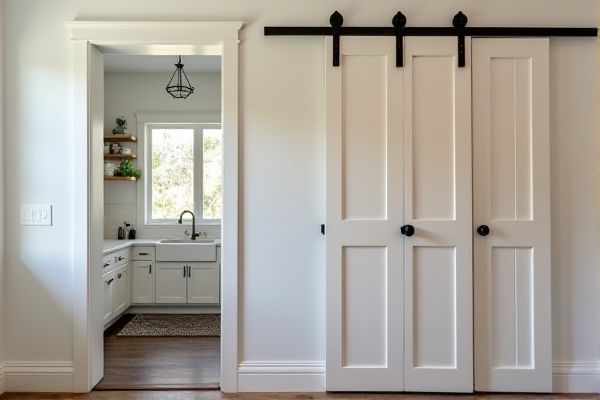
Pocket pantry doors save valuable floor space by sliding seamlessly into the wall, offering a sleek and modern look ideal for compact kitchens. Barn pantry doors provide a rustic charm and easy access but require wall space for sliding, so discover which style best suits your kitchen needs in the rest of the article.
Table of Comparison
| Feature | Pocket Pantry Doors | Barn Pantry Doors |
|---|---|---|
| Space Efficiency | Highly space-saving, slides into wall cavity | Requires wall space to slide along exterior |
| Installation | Complex, needs wall modification | Easy, mounts on wall track |
| Design Style | Minimalist, concealed | Rustic, decorative |
| Cost | Higher due to structural work | Moderate, less structural impact |
| Maintenance | Hidden hardware, harder access | Accessible hardware, easier upkeep |
| Durability | Protected inside wall cavity | Exposed to external damage |
| Noise Level | Quiet operation | Potentially noisier on track |
Introduction to Pocket and Barn Pantry Doors
Pocket pantry doors slide seamlessly into wall cavities, maximizing space in compact kitchens by eliminating door swing areas. Barn pantry doors feature a rustic, exposed track design, adding visual interest and ease of access without requiring wall recesses. Both door styles offer functional solutions for pantry entry, with pocket doors enhancing minimalism and barn doors contributing to farmhouse or industrial aesthetics.
Space Efficiency: Pocket vs Barn Pantry Pantry Doors
Pocket pantry doors maximize space efficiency by sliding seamlessly into the wall cavity, eliminating the need for extra clearance and making them ideal for small kitchens. Barn pantry doors, while stylish and easier to install, require wall space alongside the pantry for sliding, which can limit furniture placement or movement in compact areas. Your choice depends on whether you prioritize streamlined space-saving functionality or decorative, rustic charm.
Style and Aesthetic Appeal
Pocket pantry doors offer a sleek, minimalist style by sliding seamlessly into the wall, maximizing space and creating a clean, modern look ideal for contemporary kitchens. Barn pantry doors provide a rustic, farmhouse aesthetic with their exposed hardware and textured wood, adding character and warmth that suits traditional or eclectic decor. Your choice between pocket and barn pantry doors directly influences the overall design statement and ambiance of your kitchen space.
Installation Process Comparison
Pocket pantry doors require precise wall cavity modifications to create a recessed track for the door to slide into, often involving removal of drywall and installation of a sturdy frame for smooth operation. Barn pantry doors install on a surface-mounted track above the door frame, minimizing wall alterations and offering a quicker, less invasive setup. While pocket doors demand more labor and expertise due to structural adjustments, barn doors provide a straightforward installation suitable for most existing walls without extensive reconstruction.
Functionality and Daily Use
Pocket pantry doors maximize space by sliding discreetly into the wall, allowing easy access without blocking adjacent areas, ideal for tight kitchens or high-traffic spaces. Barn pantry doors offer a rustic aesthetic and sturdy function but require clearance along the wall to slide open, which can limit nearby storage or appliances. Your choice depends on whether you prioritize saving floor space or adding a bold design element that enhances daily accessibility.
Cost Analysis and Budget Considerations
Pocket pantry doors typically require more extensive installation, increasing labor costs due to the need for wall modifications and track systems, often making them pricier upfront. Barn pantry doors offer a more budget-friendly option with simpler installation and lower material expenses, as they slide on exterior rails without wall alterations. Homeowners should weigh the initial installation cost of pocket doors against the more affordable, yet visually striking, barn doors to align with their overall renovation budget.
Durability and Maintenance Needs
Pocket pantry doors offer high durability due to their recessed design, which minimizes exposure to external damage and reduces wear over time. Barn pantry doors, while aesthetically appealing with their rustic charm, require more maintenance to prevent issues like warping or surface scratches caused by their sliding mechanism and external placement. Choosing pocket doors often results in lower upkeep costs and longer-lasting performance in high-traffic kitchen areas.
Accessibility and Ease of Use
Pocket pantry doors offer seamless accessibility by sliding directly into the wall, saving space and allowing easy entry without obstruction. Barn pantry doors, while stylish, require external wall clearance for smooth operation, which can limit ease of access in tighter spaces. The choice between pocket and barn pantry doors depends on the available room and the desired balance between style and functional convenience.
Best Applications for Pocket Doors
Pocket pantry doors are ideal for small kitchens or tight spaces where saving floor area is crucial, as they slide seamlessly into the wall, maximizing usable space. Unlike barn pantry doors that swing outward and require clear floor space, pocket doors provide unobstructed access without interfering with nearby cabinets or appliances. Choosing pocket doors enhances your kitchen's functionality and maintains a sleek, minimalist aesthetic.
Best Applications for Barn Doors
Barn pantry doors are ideal for spaces where wall clearance is limited, as they slide smoothly along the exterior of the wall, saving floor space and providing easy access to your pantry. They also work well in rustic or farmhouse-style kitchens, enhancing the aesthetic appeal with their classic wooden design and visible hardware. Your choice of barn doors can create a focal point while maximizing functionality in narrow or high-traffic areas where traditional door swing would be impractical.
 homyna.com
homyna.com